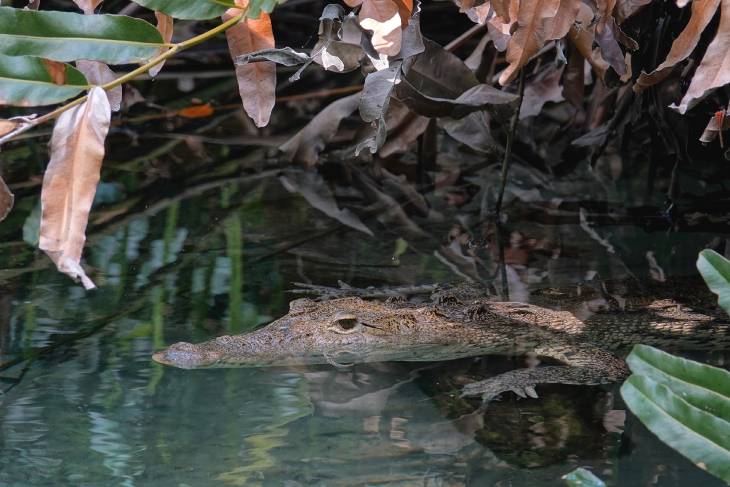The Laguna de Terminos is a coastal lagoon of Mexico located on the coast of the Gulf of Mexico, specifically in the Gulf of Campeche, on the coast of the Mexican state of the same name, southwest of the Yucatan Peninsula
Ciudad del Carmen, Campeche, (September 04, 2021).- They can be observed in the rivers or lagoons near the mangrove area, while they take “sun baths” or during the floods in colonies near the streams, it is the moreletii crocodile, one of the endangered species that inhabit the Laguna de Terminos.
23 species of crocodiles are known worldwide, three of them are distributed in Mexico, being the Moreletii crocodile ( crocodylus moreletii ) which can be located on the slopes of the Gulf of Mexico and the Yucatan peninsula, although it is also found in Belize and northeast of Guatemala.
It should be noted that it has also been introduced in the states of Sinaloa, Colima, Michoacán, Oaxaca, and Chiapas.
This species lives in freshwater, streams, mangroves, swamps, rivers, and sometimes in saltwater.

It is a reptile that lives in bodies of fresh and brackish water with slow currents, rarely found in mighty rivers.
It is common to find them in waters with little current or stagnant and very shallow, which can be clear or murky, with abundant aquatic, rooted, or floating vegetation. It lives with other species, limiting its interaction to the availability of the habitat.
Characteristics
“The swamp crocodile, as this species is also known, rarely exceeds 3 meters in length, although there are reports of males that have reached 4.5 meters,” explains Jacqueline May Díaz, spokesperson for the environmental organization Development and Environment, A.C.
They are characterized by a flattened, broad, and triangular head, a broad face, the nose, and the eyes are on the top of the head and the ears in the temporal region, all with adaptations that protect them from water.
The eyes with membranes and nostrils with muscles, which limit the flow of water.
The muzzle is relatively short and quite rounded at its point. Its length is 1.5 to 1.7 times the basal width. It is endowed with strong jaws, useful for holding and tearing prey.

The muzzle does not close hermetically, so within the oral cavity it has a kind of muscular reed or second palate, which closes the throat on the chalk of the palate, allowing it to swallow and breathe when submerged with only the nostrils above the surface, without drowning.
“The trunk of its body is elongated, the back is covered with bony plates and in the abdominal and lateral region they have scales. The tail is thick at the base, compressing in the distal portion with two rows of ridges that taper into one, it is the most important organ for propulsion. They have four short and wide locomotive limbs, the anterior with five fingers and the posterior with four, joined by a complete interdigital membrane ”.
Their average size ranges from 3 to 3.5 meters in adulthood, the males being larger than the females and with a lump in the throat similar to a dewlap.
At birth they measure between 23 and 30 centimeters, whose young are protected by the females. The back of the adults is greenish-yellow in color, becoming black and the juveniles have yellowish fringes forming crossed bands. The ventral surface of both is yellowish white without markings.

They have irregular scales on the ventral and lateral-ventral surfaces of the tail and lack osteoderms on the dorsal scales, which gives their skin great commercial importance, causing it to be persecuted by humans.
Nesting
Biologist Facundo Méndez Bautista affirms that in Mexico the nesting of moreletii crocodiles occurs during the dry season, that is, from May to June.
“The females reach sexual maturity between seven and eight years. They deposit between 20 and 50 eggs in the nests, which are generally in mounds, although on some occasions they make them floating and close to the water ”.
He explained that the young are born in August and September, during the rainy season, after an incubation of between 75 and 85 days.
Feeding
It is a strict and opportunistic carnivore, hunting alone. The type, size, and consumption of the prey is a function of the size of the animal. Small individuals feed on insects, snails, crustaceans, slugs, and mollusks.
Sub-adults and adults consume different species of mammals, birds, reptiles, amphibians, and fish.
Threats
It is associated with habitat destruction and illegal hunting.
The destruction of their habitat is due to the growth of the urban area, which sometimes causes them to be seen in areas near the mangroves during the rainy or hurricane season, in zones with floodings.

Jorge Sarricolea Chablé, director of Municipal Civil Protection, recommends to the population, especially adolescents and children, not to disturb the Moreletii crocodiles when seeing them, but to notify the authorities so that professional personnel can take charge of removing them and taking them to a safe place.
The Phoenix, protection area
On the island of Carmen, the environmental organization Alternate Movement for the Recovery of Associated Ecosystems (Blue Marea), has an area for the protection and conservation of this species known as El Fénix.

Lourdes Rodríguez Badillo, the legal representative of this organization, points out that this work dates back more than 30 years, supported with resources from projects presented before government bodies and international organizations.
This space has a conservation objective, not commercialization, so the specimens that reproduce here are released in their natural habitat.
Crocodylus / Crocodile
Species: 23 in the world, three in Mexico
The most common: Crocodylus moreletii / Crocodile moreletii
Sizes: They usually measure between 17 centimeters and 4.5 meters long
Longevity: Females live up to 40 years and males up to 30 years.
Diet: Insects, frogs, snakes and small vertebrates.
Predators: The man.
Habitat: Fresh waters and coasts of the Gulf of Mexico, mangrove areas
TYT Newsroom


